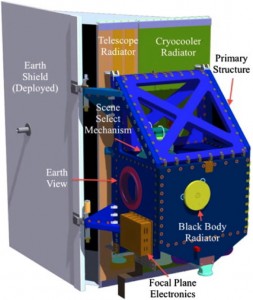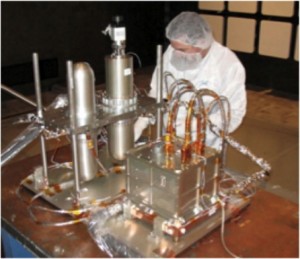Like OLI, TIRS is also a push broom sensor employing a focal plane with long arrays of photosensitive detectors (Fig. 6).
A four-element refractive telescope focuses an f/1.64 beam of thermal radiation onto a cryogenically cooled focal plane while providing a 15-degree field-of-view matching the 185 km across-track swath of the OLI. The focal plane holds three modules with quantum-well-infrared-photodetector (QWIP) arrays arranged in an alternating pattern along the focal plane centerline (Fig. 7). Each module is covered by spectral filters that transmit the two specified band widths. Each QWIP array is 640 detectors long cross-track allowing for overlap between the arrays to produce an effective linear array of 1850 pixels spanning the 185 km ground swath with a 100 m spatial resolution. TIRS will be the first spaceflight instrument to use QWIP arrays. A mirror controlled by a scene select mechanism will flip the field-of-view between nadir (Earth), an internal blackbody, and a deep space view for on-orbit radiometric calibration without changing the nominal earth-viewing attitude of the LDCM spacecraft ( [Irons and Dwyer, 2010] and [Montanaro et al., 2011]).
A mechanical, two-stage cryocooler (Fig. 8) will cool the focal plane to permit the QWIP detectors to function at a required temperature of 43 K. BATC was selected to build the cryocooler through a competitive proposal process and BATC delivered the cryocooler to GSFC for instrument integration in April 2011. The cryocooler has the same three-year design life as the rest of the instrument. Two radiators will be mounted to the side of the instrument structure, one to dissipate heat from the cryocooler and the other to passively maintain a constant TIRS telescope temperature of 185 K.
Excerpted from Remote Sensing of Environment 122, James R. Irons, John L. Dwyer, and Julia A. Barsi. The next Landsat satellite: The Landsat Data Continuity Mission, 11-21, Copyright 2012, doi:10.1016/j.rse.2011.08.026, with permission from Elsevier
Courtesy of the journal Remote Sensing of the Environment




